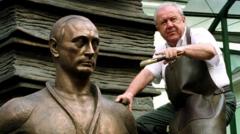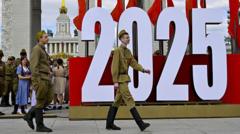The world of art mourns the loss of Georgian-Russian artist Zurab Tsereteli, who has died at the age of 91, leaving behind a legacy filled with monumental and often contentious works that reflected both his artistic vision and political connections.
Zurab Tsereteli, Renowned Sculptor and Architect, Passes Away at 91

Zurab Tsereteli, Renowned Sculptor and Architect, Passes Away at 91
Famed for his monumental sculptures, Tsereteli's work sparked both admiration and controversy across the globe.
Zurab Tsereteli, the distinguished Georgian-Russian artist noted for his sizable and often polarizing sculptures, has passed away at the age of 91. Born in Tbilisi, Tsereteli gained notoriety with various expansive projects in Moscow, such as his towering 98-meter (321 feet) monument to Tsar Peter the Great, a ruler notoriously skeptical of the city itself.
Rising to fame during the Soviet Union's reign, Tsereteli led the design team for the 1980 Olympic Games held in Moscow and crafted significant sculptures across various international cities. His close ties with Russian political leaders like Vladimir Putin were well-documented; he once expressed that Putin's "healthy soul" influenced him to create a bronze study of the president.
Moscow's Mayor Yuri Luzhkov was among the artist's close friends, and Tsereteli's privileged position allowed him to cultivate relationships globally, even meeting art legends like Pablo Picasso during travels to Paris. Following his death, Maria Zakharova, the spokeswoman for the Russian Foreign Ministry, praised Tsereteli as "an artist of world renown," asserting that he would be remembered not just in spirit but prominently through his artistic contributions.
The monumental Peter the Great statue in Moscow drew mixed reviews from residents when discussions about its future arose in 2010; its impressive height challenges that of the Statue of Liberty. Despite such mixed receptions, Tsereteli earned immense respect in art circles and held the presidency of the Russian Academy of Arts.
His grand works can be seen around the world, including an iconic monument to Christopher Columbus in Seville, Spain, and the Chronicle of Georgia monument situated in his native Tbilisi. Among his other prominent pieces is the ten-story Tear of Grief monument in New Jersey, dedicated to the victims of the September 11 attacks, a gift from the Russian government.
This profound statue, unveiled on September 11, 2006, was attended by Tsereteli and former U.S. President Bill Clinton, indicating Tsereteli’s significant role in promoting international camaraderie through art. Another notable creation, Good Defeats Evil, located at the United Nations Headquarters in New York, illustrates St. George defeating a dragon amidst broken missiles, symbolizing peace between the U.S. and Soviet Union.
Controversial moments in Tsereteli’s career reached a peak in the French town of Ploërmel, where his enormous bronze statue of Pope John Paul II faced dissent for allegedly breaching France's secular laws. Tsereteli’s monumental contributions additionally include the 110-meter (360 feet) Birth of the New World, celebrating Columbus's journey, which ultimately found its home in Puerto Rico after multiple U.S. cities declined to host it. He also created smaller works honoring illustrious figures like Princess Diana and Vladimir Putin, and engaged in architectural projects like the reconstruction of Moscow's Cathedral of Christ the Saviour.
As news of his passing spread, the art community reflects on a complex figure whose work instigated conversations on culture, politics, and artistic expression.



















